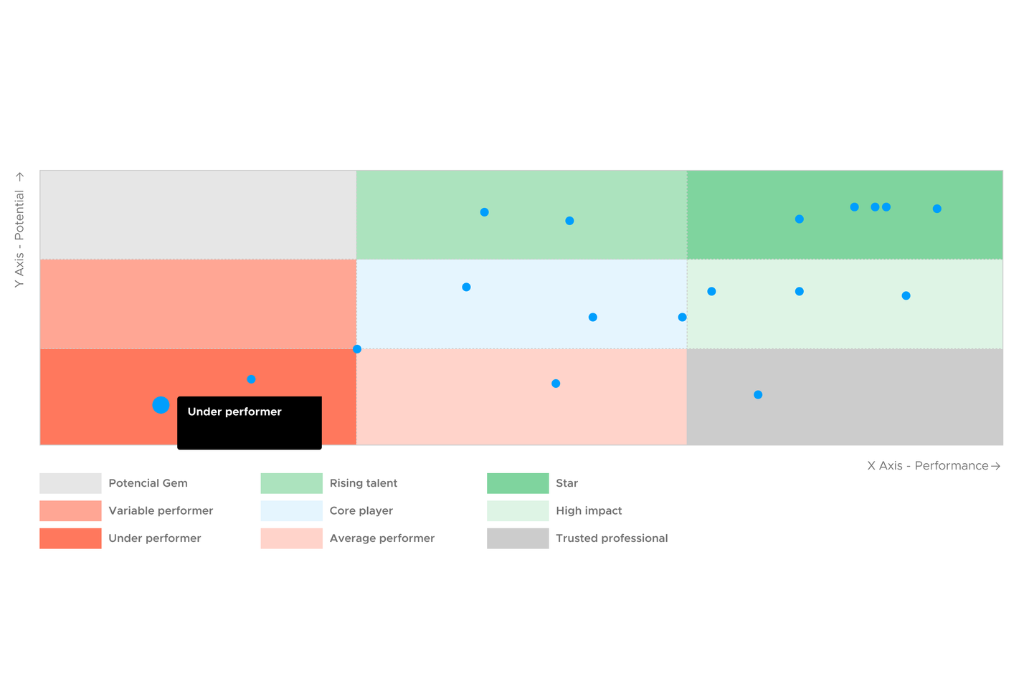Employees are a company’s most valuable asset. Engaged employees are even more so! Engaged employees are not only more productive, but also play a crucial role in improving customer satisfaction and promoting innovation, thus contributing to the overall success of the company.
Recognizing the growing importance of working on employee engagement, more and more companies are becoming aware of the imperative need to measure and track key employee engagement metrics.
Bringing employee engagement metrics and KPIs to the thread provide valuable and insightful information about overall employee satisfaction; their experiences, needs, concerns, motivations, etc. This allows organizations to identify areas for improvement to make informed decisions to create a more positive and productive work environment.
Below you will find the 10 employee engagement metrics you should not forget to when measuring employee engagement, whether you are in a very large or a very small company:
- Employee Net Promoter Score (eNPS)
- Employee Satisfaction Index (ESI)
- Employee retention rate
- Employee turnover
- New hire 90-day failure rate
- Work-life balance rate
- Employee recognition among employees
- Employee participation in surveys
- Employee absenteeism
- Employee performance
1. Employee Net Promoter Score (eNPS)
The eNPS concept is seen as the main employee engagement metric and has its origins in the widely used Net Promoter Score (NPS) in customer satisfaction. However, instead of measuring customer loyalty, the eNPS focuses on measuring employee advocacy within a company. It provides information on how likely employees are to recommend their workplace to others, reflecting their level of satisfaction and engagement.

A healthy and engaged workforce translates into a high eNPS. Conversely, a low eNPS shows that there are areas within the company that need attention. Some employees may be dissatisfied and disengaged, which can lead to increased employee turnover and decreased productivity.
Tracking eNPS over time allows companies to closely observe the evolution of their employee engagement levels and identify trends. However, it is not enough to measure eNPS periodically. Companies must take action based on the feedback received and proactively address employee concerns to improve engagement levels and create a positive work environment.
How to measure Employee Net Promoter Score (eNPS)
Calculating eNPS involves asking a single question: “On a scale of 0 to 10, how likely are you to recommend this company as a good place to work?” Based on the responses, employees are classified into three categories: Promoters (9-10), Passives (7-8), and Detractors (0-6). The eNPS score is then determined by subtracting the percentage of Detractors from the percentage of Promoters.
This score provides a single metric that can be used to benchmark and track your eNPS over time.

2. Employee Satisfaction Index (ESI)
When a company wants to measure and understand the level of employee satisfaction, many HR professionals turn to a very specific employee engagement metric: the Employee Satisfaction Index (ESI). The ESI offers valuable information about how employees feel and helps companies identify areas for improvement.
Regularly measuring and monitoring the ESI allows organizations to prioritize employee satisfaction, leading to improved morale and a more satisfying work environment for all involved. By analyzing the responses, organizations can identify strengths, weaknesses and areas for improvement, enabling them to take specific actions to increase employee satisfaction.
How to measure Employee Satisfaction Index (ESI)
The Employee Satisfaction Index quantifies employee satisfaction levels based on a variety of factors, such as salary and other company benefits, work-life balance, professional development opportunities, company culture, work environment and many more aspects. It is usually measured through surveys designed to gather employee feedback.
If your employees are working hybrid, you can consider measuring in-office employees ESI and remote employees ESI separately. In this way you will be able to conduct specific initiatives for remote workers.
To calculate a company’s ESI, divide the average value of the question by 3, and then multiply by 100.

3. Employee Retention rate
Employee retention is a critical aspect of ensuring the long-term success of any organization. High turnover has bad consequences, leading to increased recruitment costs, loss of valuable talent and decreased team productivity. Therefore, taking a closer look at our employee retention rate is key.
A company wishing to monitor the effectiveness of its employee retention efforts uses this employee engagement metric. The employee retention rate quantifies the volume of employees who remain with an organization over a given period of time. The Employee Retention Index provides information about a company’s ability to retain its employees and is a reflection of the overall employee experience within the company.
A high employee retention rate reflects a company’s strong commitment to its employees and their overall experience. It fosters loyalty, continuity and stability within the workforce, creating the foundation for sustained success.
How to measure Employee Retention rate
To calculate the Employee Retention Rate, divide the number of employees remaining in the company by the total number of employees at the beginning of the given period, and then multiply by 100.

This metric provides a percentage that represents the organization’s success in retaining talent.
4. Employee turnover rate
The employee turnover rate quantifies the percentage of employees who leave an organization within a given time frame. This employee engagement metric provides insights into the organization’s ability to retain talent and reflects the effectiveness of recruitment, onboarding, and employee engagement strategies.

Understanding the employee turnover rate helps to make informed decisions to mitigate its negative impact:
- Increases recruitment costs.
- Disrupts team dynamics
- Leads to a loss of valuable knowledge and expertise.
- Reduces employee morale.
- Decreases team productivity.
- Negatively impacts customer satisfaction.
By working on lowering the employee turnover rate, companies can retain top talent; enhancing stability and building a loyal and committed workforce.
How to measure Employee Turnover rate
To calculate the Employee Turnover Rate, divide the number of employees who left the company during a specific period of time by the employees at the start of the period plus employees to date divided by 2. Then multiply by 100.

5. New hire 90-day failure rate
It is said that the first 3 months of a new employee’s career with a company are crucial. Companies invest time and resources in hiring and onboarding the new employees. To analyze the effectiveness of this process, organizations monitor the 90-day failure rate of new employees. This employee engagement metric refers to the percentage of new employees who leave the company within their first 90 days of work.
A high 90-day failure rate may indicate problems in the hiring or onboarding process, or even regarding cultural fit. It may also reflect a mismatch between expectations and the actual tasks or work environment. Understanding the factors contributing to this failure rate is crucial for organizations to make the necessary adjustments and improve the hiring and onboarding experience.
How to measure New Hire 90-Day Failure rate
To calculate the new hire 90-day failure rate, divide the number of hires in the given period that were terminated within the first 90 days of the contract by the total number of new hires during the same time period. Then multiply the final result by 100.

When talking about the total number of new hires during the same time period, you must take into account only employees who have worked for a total of 90 days. Failing to do so will result in an incorrect New Hire 90 Days Failure Rate.
6. Work-life balance rate
The Work-Life Balance Rate measures the extent to which employees are able to maintain an equilibrium between their professional responsibilities and personal lives.
When measuring this employee engagement metric in your surveys, bear in mind including questions about various aspects such as schedule flexibility, remote work, workload, and company support on personal responsibilities. Take a look at a few example questions in a section below.
How to measure Work-Life Balance rate
Measuring work-life balance has become key in recent years as employees are giving it more importance than before. In fact, 25.8% of employees said that their work affects their personal life.
To properly measure your work-life balance you can use Nailted. You will be able to create your own custom metrics. To feed those metrics, you can automatically design and launch custom surveys with customized, pre-configured questions covering all relevant areas of work-life balance, or the area or initiative you want to measure.

7. Employee recognition among employees
Fostering a culture of appreciation is key to creating a positive and engaging work environment that motivates employees to perform at their best. That’s why it’s highly recommended to monitor how employee recognition works overtime.
By measuring employee recognition, companies can understand employees’ preferences and make informed decisions to improve their recognition programs. By closely looking at this employee engagement metric, companies can create a positive work environment where employees feel valued and appreciated.
How to measure Employee Recognition among employees
Measuring employee recognition involves assessing various aspects:
- The frequency.
- Participation regarding the volume of messages sent.
- Participation regarding the volume of messages received.

An employee engagement tool like Nailted can help you collect that information. You can also send surveys specifically dedicated to get employees’ perceptions on recognition initiatives. You may have collected results on the frequency and volume of messages sent and received, but without asking employees you cannot know if that’s enough for them.
Conduct anonymous surveys and ask the right questions to understand the impact it has on employees’ motivation and job satisfaction. You have a few questions about employee recognition in a section below.
8. Employee participation in surveys
Employee surveys are a valuable asset for companies to collect employee opinions that enable them to make data-driven decisions. However, without good participation rates we do not get representative and reliable results, and these surveys cannot be successful.
Measuring employee participation in surveys is very important to collect reliable data. In this way, HR teams can identify barriers to participation and take proactive steps to improve this important employee engagement metric. Initiatives can include fostering a feedback culture, addressing communication gaps, ensuring survey anonymity, and demonstrating the value of their feedback by implementing employee engagement initiatives based on their comments.
How to measure Employee Participation in surveys
Employee participation in surveys is measured by response rate. Get the response rate by dividing the number of completed surveys by the total number of employees invited to participate. Then multiply the final result by 100. This will result in the percentage of employees who actively participated in the survey.

9. Employee absenteeism
It’s important to track employee absenteeism, voluntary or involuntary, as it can have significant implications for productivity, team dynamics, and employee well-being.
In addition to obtaining quantitative data on absenteeism, which we will discuss below, we recommend collecting data on the reasons for employee absences. Categorizing absences can help you understand the causes and take action to address them.
How to measure Employee Absenteeism
Calculate employee absenteeism by dividing the total number of days employees were absent by the total number of workdays. Then multiply the final result by 100. This resulting percentage reflects the frequency of employee absences.

Within your employee absenteeism rate, you can assess the duration of those absences by tracking the average length of time employees are absent from work. Doing so can help you identify trends that may require your attention.
You can also compare absence rates across teams or time periods. This makes it easier to identify the areas with the highest absenteeism and explore the reasons contributing to it.
10. Employee performance
To run a successful business, it is essential to measure employee performance. Taking this employee engagement metric into account allows HR teams to assess individual and team contributions to the company, identify areas for improvement and align performance with business goals. By correctly measuring performance, companies can improve productivity and drive employee development, resulting in sustainable success.
By measuring employee performance, it is easier to identify high performers, recognize areas that may need additional support or even training. This will help make informed decisions about promotions, rewards and career development opportunities.
How to measure Employee Performance
Measuring employee performance involves evaluating the quality and quantity of work performed by employees.
We recommend evaluating the performance of individual employees to then get an overview of the whole team, and scale it to the company. You can do this by conducting performance reviews to evaluate performance against objectives. The best way to get a more complete picture of an employee’s performance is to conduct 360 performance reviews.
Nailted allows you to design and implement performance reviews based on 360 feedback. These 360 performance reviews help you gather information from multiple sources and get a more complete picture of your workforce’s performance and evolution over time.

You can also use objective metrics, such as sales targets, customer satisfaction ratings or project delivery schedules, to evaluate performance. These metrics provide tangible benchmarks and facilitate performance comparisons.
When it comes to tracking employee engagement metrics and KPIs, using a strong tool in People Analytics is highly recommended. Nailted is an employee engagement platform that offers a comprehensive solution to help organizations understand their teams at a deeper level by making the most of data.

By leveraging advanced analytics and data-driven insights, Nailted helps companies to effectively measure, monitor and improve employee engagement. With Nailted, you can access valuable employee engagement metrics such as eNPS, satisfaction, recognition and many more. In this way you can make informed decisions and drive positive change within your company.
By harnessing the power of people analytics, you can unlock a large amount of information about your employees, leading to better employee engagement strategies, increased retention rates, and ultimately a more productive and satisfied team. If you wish to gain valuable insights about your employees and take your employee engagement initiatives to new heights, Nailted sure helps!










